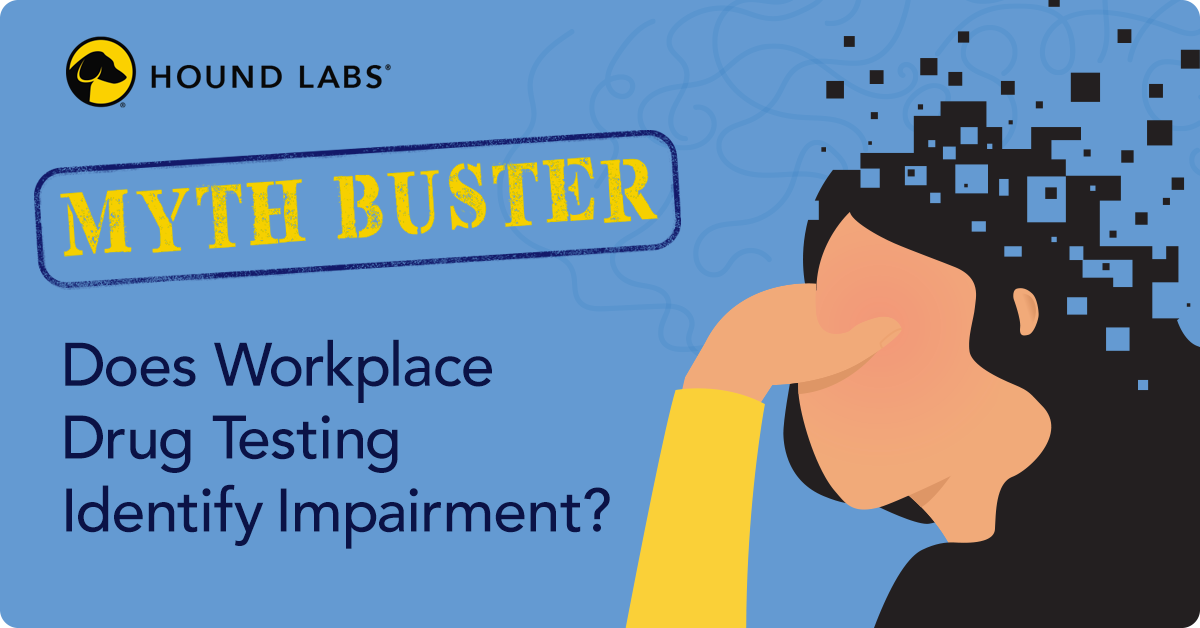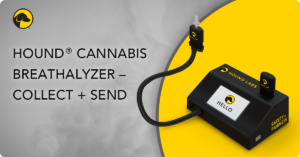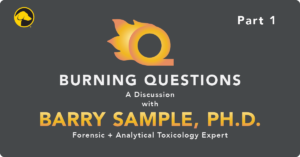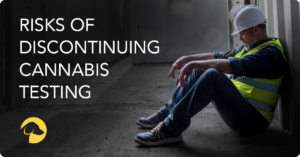
Does Workplace Drug Testing Identify Impairment?
Every dog (or should I say hound?) has its day. Likewise, it seems every state has its own unique cannabis laws. Despite the fact that cannabis remains illegal at the federal level, some states have legalized it for recreational or medicinal use. Some states are providing new employment protections for off-duty marijuana use among employees. And some states are even passing laws related to “detecting impairment” — a rather vague and subjective standard that’s not yet based on scientific measurements or standards.
I examined this topic during a recent webinar that aimed to answer this question: Is the intent of workplace drug testing to detect impairment or to deter use to begin with?
As a complement to that webinar, I thought I’d write about it, too. Let’s take a look at where this perception of an impairment standard comes from and what you need to know as an employer.
MORE USE + MORE LAWS = MORE CONFUSION
Changing cannabis laws are leading to more access and use. Nearly 40 states have some version of legalized cannabis, and more than 185 million adults in the U.S. have legal access to cannabis.1 This potent combination of increased use and fast-moving, wide-ranging legislation has led many employers to ask my team at Hound Labs about the solutions we have available to identify impairment. As an employer, you need solutions that limit your exposure to cannabis-related risks while remaining in compliance with applicable laws. But when it comes to detecting cannabis impairment, as my industry colleague Faye Caldwell, founding partner of employment law firm Caldwell Everson says, there is no drug test in the market today that can detect impairment, and there is no agreed-upon defined standard.
“When legislators write these types of laws, the rest of us are left to try to interpret them and understand what they mean and what the implications are. The challenge is that some of the laws are vague, and some states have different measures of impairment and different definitions of impairment because they’ve concentrated on trying to do what they think is best for their state,” says Caldwell.
The result is a confusing mixed bag of messages for employers, which unfortunately limits them from optimizing the real intent of drug testing – deterring drug use among employees before or during work hours.
THE ALCOHOL CONUNDRUM
Part of the confusion around impairment comes from trying to make a direct comparison between alcohol and THC. In most U.S. states and Washington, D.C., it’s illegal to operate a vehicle while having a Blood Alcohol Concentration (BAC) of 0.08% or greater.2 Someone with a high tolerance to alcohol, however, may not experience safety-impacting effects at that level.3 But they could still be cited for Driving Under the Influence (DUI) based on the quantitative standard.
Research over decades shows that, on average, alcohol follows an established post-consumption metabolization pattern. Because of this, states are able to rely on a per se law that makes it illegal in and of itself to operate a motor vehicle at or above the established BAC level.4 This is regardless of whether or not the driver exhibits visible signs of safety-impacting behaviors.5
That same standard does not yet exist for cannabis, partly because its classification as a Schedule I drug has prevented some of the research necessary to determine a quantitative standard under which a user would be considered impaired.
“The legislators drafting this language may have thought of it like alcohol, and there’s a legal, per se, limit for alcohol,” says Dr. Barry Sample, a leading toxicology and workforce drug testing expert, and Hound Labs science advisor. “So, why couldn’t they do the same thing for cannabis? Well, we know that the science and the technology just aren’t there to support that same determination.”
With all that in mind, now the question is: What are employers supposed to do in the meantime while legislators keep passing laws based on a yet-to-be-determined impairment standard?
BRIDGING THE GAP
For years, companies have relied on oral fluid, urine, and hair to test for THC. These test types are implemented to deter use. And, for a while, they’ve worked: through the 1990s, 2000s, and into the early 2010s, positive cannabis drug tests trended downward. In recent years, however, that has begun to reverse as access to legal cannabis has increased, and legislators have attempted to focus on impairment.6
Employers now need a solution to help them bridge the gap between what these laws are trying to accomplish to combat increasing cannabis use and what tools employers have at their disposal to help deter cannabis use.
BREATH TESTING BENEFITS
Regardless of whether or not your state has passed legislation that enables greater access to cannabis, it’s an ideal time to reevaluate your company’s drug testing policy. Ultimately, employers do not want employees to use cannabis shortly before or during work hours.
Breath testing narrows the window of cannabis detection. The detection window of a cannabis breath test only extends for 2-3 hours after use. With the shortest detection window in the drug testing industry, a breath test enables employers to detect and deter use correlating to the employee’s workday. This precise detection window helps employers enforce policies that prohibit use immediately before or during work but do not penalize employees for cannabis use outside of work, as outlined in the employer’s policy.
As for the original question posed by this blog -– Is the intent of workplace drug testing to detect impairment or to deter use to begin with? – the answer is simple. Impairment is still an undefined standard, and the goal of drug testing remains rooted in deterrence and detection. Perhaps most importantly for employers, breath testing now provides an objective cannabis measure that can help identify recent use.
If you have questions about updating your drug testing policy and implementing the HOUND® CANNABIS BREATHALYZER in your workplace, reach out to our sales team for assistance.
Footnotes
1 U.S. Census
2 National Safety Council
3 Cleveland Clinic
4 Ibid
5 Ibid
6 Quest Diagnostics Drug Testing Index™

August 17, 2023
By SAMMIE DABBS
Chief Revenue Officer
Share













